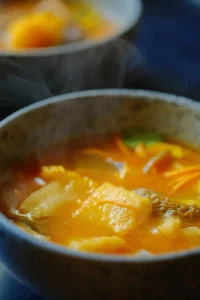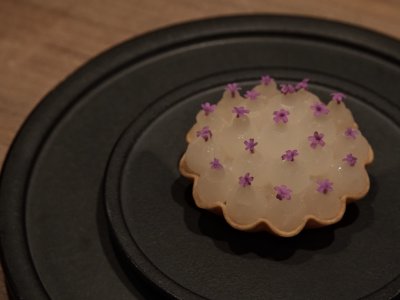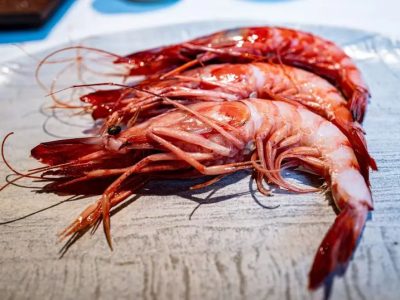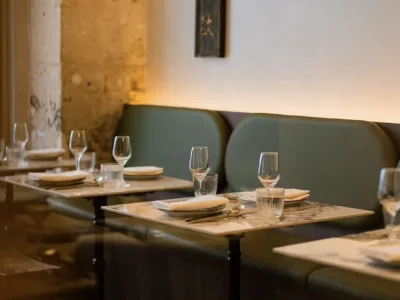Lamdre, a plant-based restaurant in Beijing's bustling Sanlitun district, embraces an ambiance of tranquility through its symmetrical and minimalist design, creating an environment that embodies the Zen philosophy of purifying the mind and body. Distilling the essence of Japanese and Scandinavian design into a wabi-sabi aesthetic, combined with Chef Dai Jun's masterful plant-based dishes, the restaurant invites each guest to find inner peace and savour the bountiful gifts of nature.
@Jocelyn華姐's TastyTrip YouTube
Last year, I first heard about Lamdre from a very trusted chef friend who spoke highly of it, but seeing is believing. Lamdre is situated in a tranquil corner amidst the hustle and bustle pf Sanlitun, one of Beijing's trendiest districts. The pitched roof of the second floor gives the impression of being in Northern Europe.
The owner, Zhao Jia, is like a curator. From meticulously crafted space to the last detail of the tableware, everything is well thought out. She advocates for nature and sustainability, ensuring ingredients are locally sourced and traceable. More importantly, she offers vegetarian dishes that everyone can pleasantly embrace. To decouple plant-based dining from religious connotations, Lamdre provides a well-constructed wine list, making it an option for non-vegetarians seeking fine dining experience.
My experience at Lamdre truly reflected the owner's vision. The service was exceptionally warm and spirited. Chef Dai Jun has intensive experience working in renowned vegetarian restaurants, including King’s Joy and Vege Wonder, making him one of the key figures in China's plant-based food scene. Chef Dai keeps a low-key profile and is sometimes a bit shy in conversations, but he is said to be extremely hardworking, always keeping his ideas up to date by researching global food trends.

My experience at Lamdre truly reflected the owner's vision. The service was exceptionally warm and spirited. Chef Dai Jun has intensive experience working in renowned vegetarian restaurants, including King’s Joy and Vege Wonder, making him one of the key figures in China's plant-based food scene. Chef Dai keeps a low-key profile and is sometimes a bit shy in conversations, but he is said to be extremely hardworking, always keeping his ideas up to date by researching global food trends.
Chef Dai started his culinary career with Cantonese and Chaozhou cuisine before delving into vegetarian cuisine. He shares that in the ten years since he entered this field, he tried imitating meat flavours and using pricey mushrooms before finally conveying his culinary concept through creativity. Although Lamdre's dishes may seem unbound by conventional techniques, they are fundamentally anchored in Asian flavours and are never weak in taste – a factor I believe is key to Chef Dai’s success in standing out and thinking outside the box.
Vegetarianism is inclusive, like Noma's vegetable-focused seasons. The goal is to please all diners, not just vegetarians. More people are open to vegetarian dishes now, including myself, especially when I’m more aware of health and the impact of greenhouse gas emissions generated by cattle farming. Besides, the increasingly tasty, refined veggie food has made plant-based meals become a part of my diet. Lamdre’s autumn-winter menu has a stunning opener with appetizers such as ginkgo, peach gum, and lantern fruit. The ginkgo dish is particularly delightful, featuring sweet, soft green ginkgos picked from ancient trees in Tengchong of Yunnan, paired with walnut kernels harvested last autumn, toasted almond slices, seasoned with traditional Italian balsamic vinegar and peanut butter, and garnished with clerondendrum (chains of glory) for added fragrance. The first bite brings joyous crispness, accompanied by a complex aroma of various nuts, all embodying the unique, rich flavours of autumn.
Noma's pop-up in Kyoto last year also featured peach gum. Lamdre's approach is to pair it with marinated wild Bachu mushroom on a sheet of seaweed crisp, topped with crushed macadamia nut for texture and draped with purple clover, evoking the air of an autumn forest – Nordic in appearance but unmistakably Chinese in flavour. Lantern fruit is turned into jelly together with akizuki pear juice, encasing cherry tomato and akizuki pear, dusted with dried mango powder for a golden touch.
For the pumpkin dish, the chef uses organic pumpkin from the outskirts of Beijing to extract its original juice without adding any water. The pumpkin is sliced and pickled with preserved plums for a crisp texture – a clever pairing that reminds me of the boiled cabbage in Sichuan cuisine. Another dish features sweet bamboo shoots from Baoshan County in Yunnan. The grilled bamboo shoots wrap around wild rice stem and green shoots, served with a peppery sauce, hinting at a subtle charcoal aroma. Refreshing and appetizing. A dish resembling two lychees is, surprisingly, made from tofu. It uses top-layer handmade tofu skin from Taizhou, marinated with pine nut and coated with peanut and crispy chili pepper. The tofu is infused with bamboo charcoal and pine needle oil, giving it a hint of forest. Chef says the inspiration comes from a street snack in Hebei, adding a touch of down-to-earth charm with its distinct taste. The Buckwheat dish features a pancake made from Hulunbuir buckwheat, paired with crunchy dried tofu skin made from organic chicken egg and pistachio from Hangzhou, along with fresh cucumber and cilantro. When rolled up, it's like eating Peking duck and a Chinese crepe, with a delightful interplay of savoury and sweet flavours, offering a crispy and delicious experience.
For the winter menu, Chef Dai prepares a heartwarming sour soup hot pot, with a presentation artfully conveying a sense of nature. The broth includes ingredients from the Yunnan-Guizhou region such as tree tomato, sour papaya, lemon, and fresh lemongrass, using their acidity to bring out a fermented flavour, while the lemongrass adds an aroma reminiscent of Tom Yum soup. A mini ecosystem displayed on the table captures the colours of autumn, featuring morel mushrooms, golden fungus, cordyceps, walnut mushrooms, and bamboo fungus. The chef picks these ingredients directly from where they are cultivated and places them into the soup, which are then boiled and ready to be enjoyed – a process that mirrors the cycle of life and the gifts of nature.

Sour Soup, Tamarillo, Chinese Quince,Fungus
Next is a dainty and adorable vegetable dumpling, with a wrapper made from pak choy greens and kale, encasing a filling of crunchy stem, water chestnut, and edamame – sweet and refreshing. Another dish features pickled radish mixed with Taizhou soybean dough, stir-fried with homemade vegetarian XO sauce and topped with crispy fried red quinoa for an appealing colour contrast, resembling a Cantonese radish cake. A taro dish uses Lipu taro from Guangxi, with the rich aroma of baked taro skin, paired with baby taro, deep-fried taro shreds, and crispy rice for a multi-layered experience. Very rich and satisfying.
The rice dish features Wuchang rice paired with small potato, Chaozhou dry pickled turnip, porcini and Taizhou rosary pea. At the table, the earthen pot is opened, added with red-hot charcoal, followed by a few drops of vegetable oil before quickly covering the lid again, using smoke to infuse a charred aroma into the rice. Some shredded mustard greens are finally added for an extra vegetal touch. The combination of textures brings to mind a variation oncifantuan (sticky rice roll).
With the changing global trends, vegetarianism is no longer solely associated with religious connotations. Lamdre’s dishes offer a complex flavour profile, not constrained by conventional vegetarian cooking. The winter menu features rich, intense soups as well as vibrant elements of umami, offering a particularly comforting experience for cold days like these.
Vegetarian cuisine is currently a global trend, and Chef Dai Jun has elevated the dishes at Lamdre to a new height. He admits that making vegetarian dishes poses greater challenges than meat-based ones because the inherent flavours of vegetables are harder to present. This requires better understanding and sense of processing ingredients, which is why skilled chefs specializing in vegetarian cuisine are hard to come by.
Chef Dai Jun shares his secret to maintaining creativity: passion, curiosity, ready to back to square one, and always delve deeper into plant-based cuisine. Some dishes are variations of traditional dishes, but the menu flows seamlessly with well-balanced flavours and meticulous seasoning, achieving a high level of refinement. Chef Dai Jun masterfully handles taste profiles and cooking techniques, breaking the constraints of conventions and forging his own path while also aligning with the global trend.
The dishes of Chef Dai are predominantly Asian-inspired, a sentiment shared by many chefs who understand that no matter how far they venture, they must never forget their roots.
Author: Jocelyn Chen
Photo: Lamdre Beijing/Instagram






